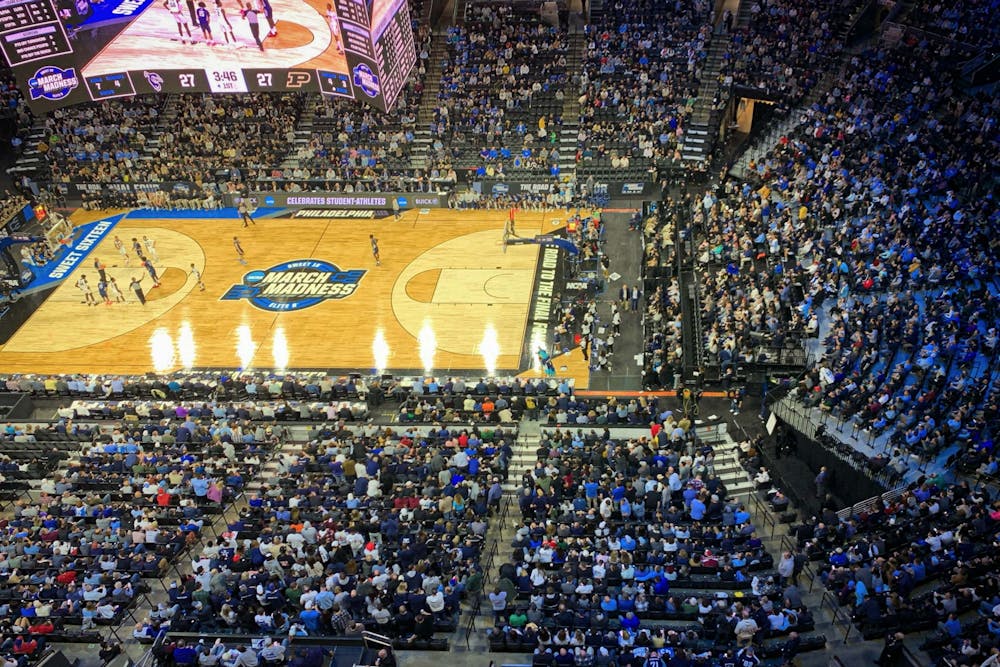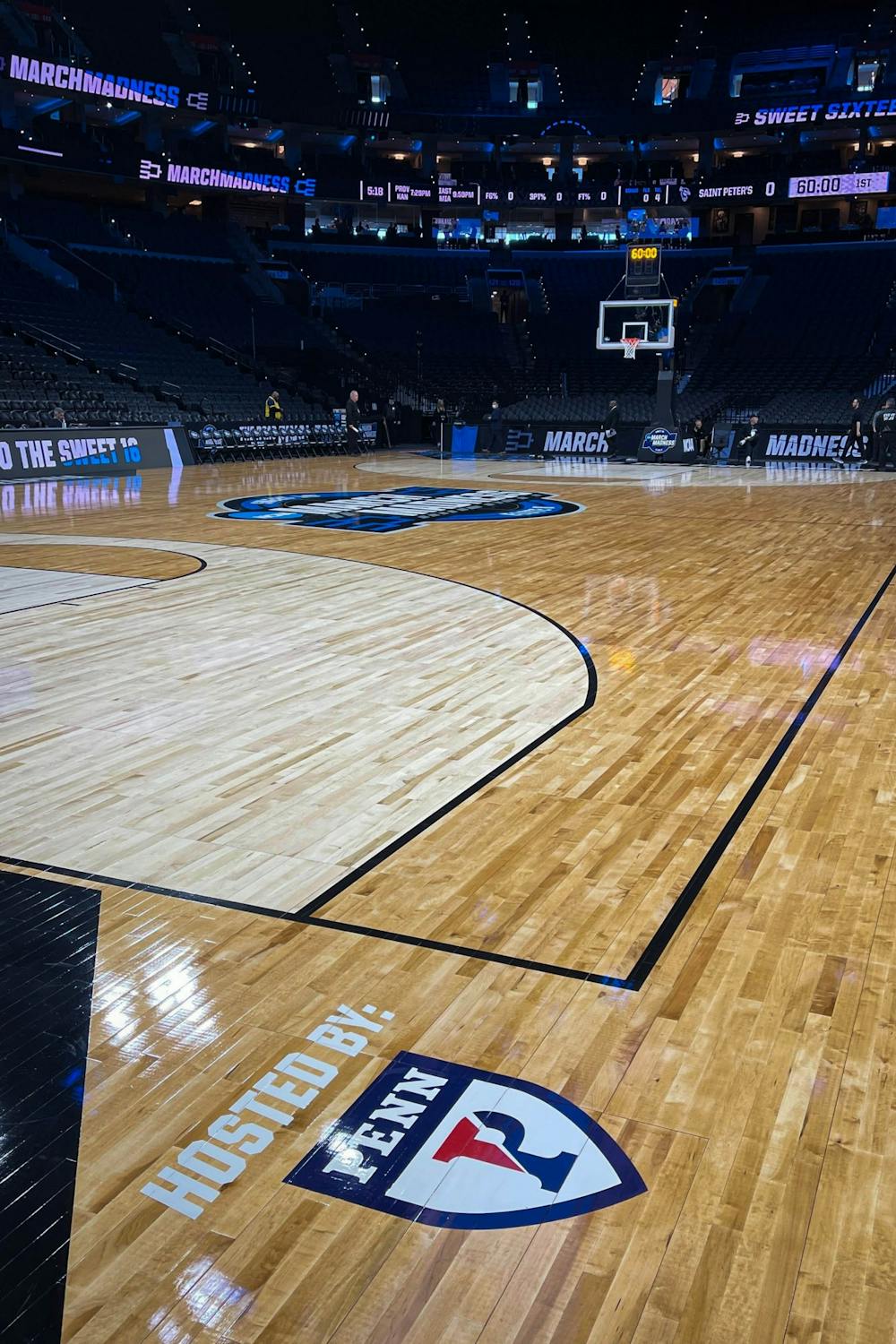
With 38 seconds left to play in Friday’s first Sweet Sixteen matchup at the Wells Fargo Center, thousands of St. Peters fans (and bandwagon Peacocks supporters) cheered on the Cinderella story that was about to take down the heavily-favored Purdue Boilermakers. St. Peters’ bench was much the same, and on the floor below them was a tile on the court that pictured the University of Pennsylvania shield emblem.
The University placed a bid in conjunction with the Wells Fargo Center and PHL Sports to host a March Madness regional tournament in 2017, and five years later, the endeavor came into fruition with the men’s basketball East Regional this past weekend. The games were eventful, with the aforementioned Peacocks taking out the Boilermakers and the North Carolina Tar Heels edging out the UCLA Bruins, both in tight contests on Friday. On Sunday, the Tar Heels raced past St. Peters to win the regional championship and advance to the Final Four.
“[We were initially surprised that] St. Peters would be there,” Scott Ward, Penn Athletics’ senior associate athletics director, chief operations officer, and tournament manager, said. “When we saw our bracket on Selection Sunday, there was extreme excitement for our top four seeds and UNC. When Kentucky and Baylor lost, we were a little concerned about the fan interest of our games, but on Friday, 90% of the crowd was cheering for St. Peter’s, and UNC always has a great following, so to get those two fan bases in the final, we were extremely pleased at the end of Friday night.”
Overall, the event was a major success with no major roadblocks, according to Ward. All three games had sellout crowds and were televised live on CBS. The preparation, which began last Tuesday, was an extensive process.
“Wells Fargo Center had a Sixers game Monday night, [and] then their conversion crew emptied the building,” Ward said. “The NCAA court floor was delivered at 6 a.m. the next day and set up started. After the floor, the NCAA brought in the digital scorer’s table, then Spalding set up the basketball backstops [hoops], and we were underway. Wells Fargo Center staff built seating walls and corrals, set up chairs, built two walls to separate media space, and finished setting up the press areas.
“Our staff were down on Tuesday to bring down locker room supplies, set up locker rooms, training rooms, and working offices, and Wells Fargo Center staff hung all the signage. All of this was on the event floor level while their staff continued to set up and prepare for all-fan areas on the concourse, clubs, suites, and balconies.”

Off the court, all four teams enjoyed their experiences in the City of Brotherly Love. Most notably, the Bruins and head coach Mick Cronin paid a visit to Penn men’s basketball head coach Steve Donahue Wednesday evening at the Palestra. The Bruins players got to explore the Cathedral of College Basketball, while Donahue and Cronin talked about their respective teams and shared journeys in college basketball.
“The college basketball community is very tight, and UCLA reached out to coach Donahue, and Penn director of basketball operations Sarah Parks to set up a practice,” Ward said. “I’m sure the allure of the Palestra was part of it, but they actually practiced in Rockwell Gymnasium and only toured the Palestra.”
Penn Athletics Director Alanna Shanahan served as the tournament director. Ward and his team were in charge of the grunt work for the event, like setting up the team’s locker rooms, getting the teams through security, and arranging different practices and shootarounds. Around 100 volunteers helped out with the vent, split in duties between setting up and assisting with media operations. Hundreds of arena staffers also worked the event, helping with selling concessions, taking tickets, and ushering people to their suites.
Penn’s Director of Athletic Communications, Mike Mahoney, was in charge of managing the media, which involved credential distribution, press seating, and holding press conferences. While many media from North Carolina, Indiana, Los Angeles, and the New York area were there covering their respective teams, lots of media members from local Philadelphia stations or newspapers also showed up to cover the games.
Mahoney’s team of external volunteers, made up of Penn basketball managers and students from Penn and other Philadelphia-area universities were involved with tasks such as handing out stats during the game, refilling beverage coolers, and making sure that only credentialed members were allowed to enter the court-side area.
The event itself was a big step forward for Penn Athletics, which hopes to begin hosting more major athletic events, such as the Ivy League Basketball Tournament and other NCAA competitions.
“We definitely put on a good show and I’ve heard from several NCAA executives in attendance that they were very pleased,” Ward said. “I heard from several media and production partners that everything ran very smoothly. So if the teams were pleased (even the ones that lost) and the fans had a good time in Philly, then we hit a home run. There’s a reason this event is in Philly every four to five years. The NCAA trusts the staff, Wells Fargo has a great venue, and the city of Philadelphia is a great basketball town.”
The Daily Pennsylvanian is an independent, student-run newspaper. Please consider making a donation to support the coverage that shapes the University. Your generosity ensures a future of strong journalism at Penn.
Donate




